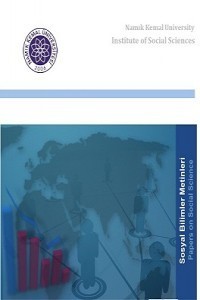TÜRKIYE’NIN İHRACATI VE İTHALATI ARASINDA ASİMETRİK BİR İLİŞKİ VAR MIDIR?: AMPİRİK KANITLAR
Bu çalışma Türkiye’nin ithalat ve ihracat malları arasında, 1960:1-2019:8 periyodu için asimetrik bir ilişki olup olmadığını bulmayı amaçlamaktadır. Aylık veri kullanılmıştır. Ampirik sonuçlara göre, ithalat ve ihracat arasında doğrusal olmayan bir bağlantı bulunmaktadır. Bu sebeple, herhangi bir asimetrik ilişkiyi tespit etmek için NARDL metodu kullanılmıştır. Seriler arasında uzun dönemli asimetrik ilişki bulunduğu saptanmasına rağmen, kısa dönemde bu ilişkinin varlığı tespit edilememiştir. Türkiye’nin ihracatında gerçekleşen %1’lik bir artış, ithalatında %0.746’lık bir yükselmeyle sonuçlanmaktadır. Diğer yandan, ihracatta oluşan %1’lik bir düşüş, ithalatı %0.669 oranında azaltmaktadır. Model diagnostik testleri otokorelasyon, değişen varyans (heteroskedasticity) ve yanlış model belirlenmesi (misspesification) gibi sorunların bulunmadığını göstermektedir.
IS THERE AN ASYMMETRIC RELATIONSHIP BETWEEN EXPORTS AND IMPORTS IN TURKEY?: AN EMPIRICAL EVIDENCE
This study tries to find out if there is an asymmetric relationship between the value of imported goods and the value of the exported goods in Turkey for the monthly periods of 1960:1-2019:8. According to empirical results, the linkage between imports and exports is nonlinear. Thus, NARDL approach is conducted in order to determine the existence of any asymmetric relationship. It is found that there is an asymmetric relationship between the series in the long run but not in the short run. 1% increase in the exports results in a 0.746% increase in the imports of Turkey. On the other hand, when the exports decrease by 1%, it decreases the imports by 0.669% in Turkey. Model diagnostic tests show no autocorrelation, heteroscedasticity or misspecification problems in the model.
___
- Afzal, M. (2008). Long-run relationship between imports and exports: Evidence from Asian countries. The Singapore Economic Review, 53(02), 261-278.
- Bahmani-Oskooee, M. (1994). Are imports and exports of Australia cointegrated?. Journal of Economic integration, 9(4), 525-533.
- Bahmani-Oskooee, M., & Rhee, H. J. (1997). Are imports and exports of Korea cointegrated?. International Economic Journal, 11(1), 109-114.
- FRED (2019). Fred Economic Data. Retrieved August 25, 2019, from: https://fred.stlouisfed.org/categories/32344
- Husein, J. (2014). Are exports and Imports cointegrated? Evidence from nine MENA countries. Applied Econometrics and International Development, 14(1), 123-132.
- Hye, Q. M. A., & Siddiqui, M. M. (2010). Are imports and exports cointegrated in Pakistan? A rolling window bound testing approach. World Applied Sciences Journal, 9(7), 708-711.
- Michael, H. (2002). Causality between exports, imports and income in Trinidad and Tobago. International Economic Journal, 16(4), 97-106.
- Mohamed, M. B., Saafi, S., & Farhat, A. (2014). Testing the causal relationship between exports and imports using a Toda and Yamamoto approach: Evidence from Tunisia. Presented at the International Conference on Business. Vol. 2, 75-80.
- Narayan, P. K., & Narayan, S. (2005). Are exports and imports cointegrated? Evidence from 22 least developed countries. Applied Economics Letters, 12(6), 375-378.
- Pesaran, M. H., Shin, Y., & Smith, R. J. (2001). Bounds testing approaches to the analysis of level relationships. Journal of applied econometrics, 16(3), 289-326.
- Shin, Y., Yu, B., & Greenwood-Nimmo, M. (2014). Modelling asymmetric cointegration and dynamic multipliers in an ARDL framework. In W.C. Horrace & R.C. Sickles (Eds.), Festschrift in Honor of Peter Schmidt (pp. 281-314). New York, NY: Springer Science & Business Media.
- Tang, T. C., & Alias, M. H. (2005). Are imports and exports of OIC member countries cointegrated? An empirical study. Labuan Bulletin of International Business and Finance, 3, 33-47.
- ISSN: 1308–4453/1308–4895
- Yayın Aralığı: Yılda 2 Sayı
- Başlangıç: 2008
Sayıdaki Diğer Makaleler
TAYLOR KURALI’NIN GEÇERLİLİĞİ ÜZERİNE BİR ANALİZ: TÜRKİYE UYGULAMASI
AVRUPA BİRLİĞİ VE SELF DETERMİNASYON: "İSKOÇYA" ÖRNEĞİ
Rasyonel ve Duygusal Müşteri Deneyimi
SİYASAL KÜLTÜR VE YÖNETİM ŞEKLİ: PUTİN DÖNEMİ RUSYA
EKONOMİK ÖZGÜRLÜĞÜN YERALTI EKONOMİSİ ÜZERİNDEKİ ETKİSİ: PANEL ANALİZ
Jülide YALÇINKAYA KOYUNCU, Hüseyin Safa ÜNAL
AVRUPA BİRLİĞİ VE SELF DETERMİNASYON: "İSKOÇYA" ÖRNEĞİ
BENLİĞİ, SAĞLIĞI VE BEDENİ UMUT VE AHLAK SÖYLEMLERİYLE DENETLEMEK
